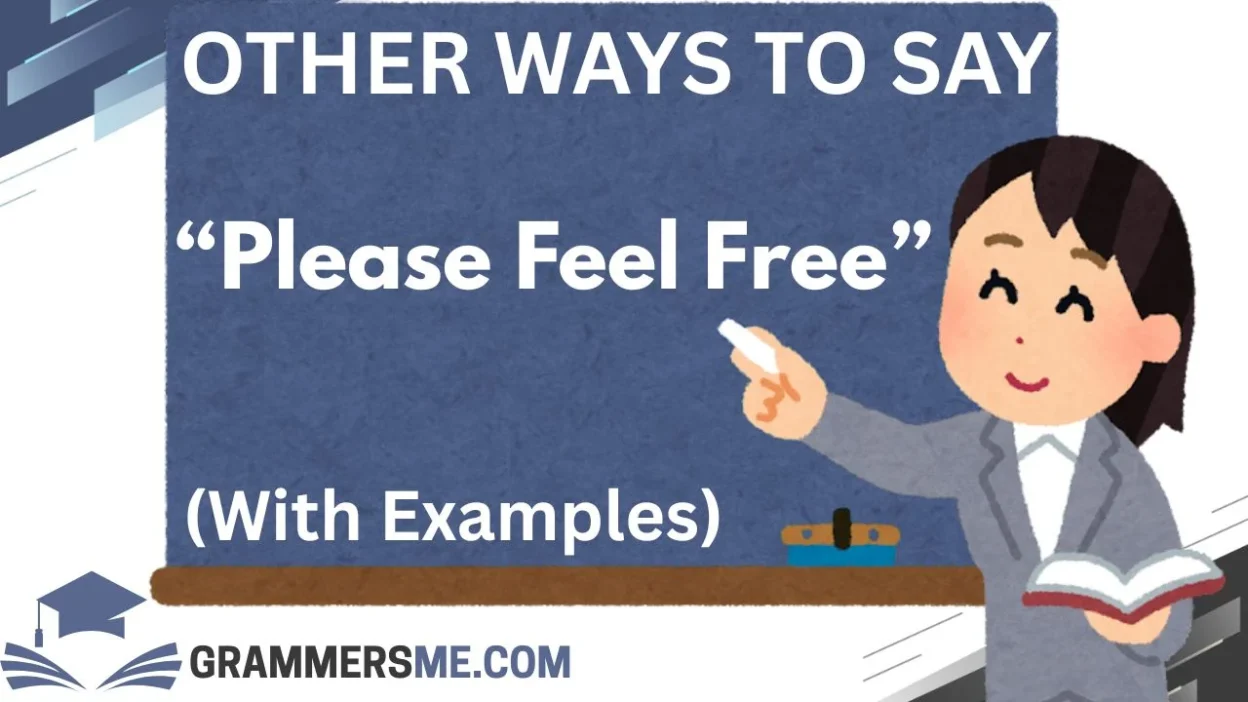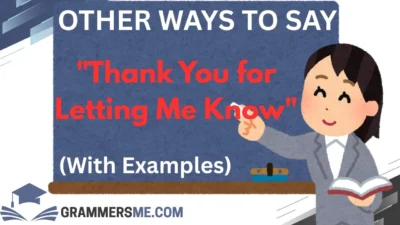When we communicate, the words we choose can significantly impact how our message is received. Saying something like “please feel free” is a warm, open invitation, but sometimes it’s helpful to find alternative phrases that resonate more personally or suit different situations. Whether you’re in a professional setting or just looking to express yourself with more care, knowing how to vary your expressions can make all the difference.
In this article, we’ll explore 30 other ways to say “please feel free”, providing you with rich, empathetic alternatives that will help you communicate thoughtfully and with warmth.
What Does “Please Feel Free” Mean?
“Please feel free” is a phrase often used to give someone permission or encourage them to act without hesitation or restriction. It’s a polite, gentle way of signaling that the person has the liberty to proceed with something without worry. This can be especially useful in both professional and personal communications to create a welcoming, non-pressured environment.
Is It Professional/Polite to Say “Please Feel Free”?
Yes, “please feel free” is generally considered professional and polite. It conveys openness and respect, making it suitable for emails, meetings, and casual conversations. However, depending on the context, you might want to choose other phrases that are more formal or less familiar. For instance, in highly formal business settings, you might opt for alternatives that sound more polished or neutral.
1. “Don’t Hesitate to”
Meaning: This phrase encourages someone to take action without delay or reluctance.
Detailed Explanation: It expresses that there’s no need for hesitation in performing an action.
Scenario Example: “Don’t hesitate to reach out if you need any further assistance.”
Best Use: When offering support or assistance in both personal and professional contexts.
Not Use: In overly casual settings, as it may come off as a bit too direct.
Tone: Friendly, supportive.
2. “Feel Free to”
Meaning: A direct way to grant permission or make an invitation.
Detailed Explanation: It’s a simple and casual alternative to “please feel free,” with the same warm invitation.
Scenario Example: “Feel free to call me anytime if you have questions.”
Best Use: Casual, friendly conversations or emails.
Not Use: In formal business communication where a more structured tone is required.
Tone: Casual, approachable.
3. “Go Ahead”
Meaning: This phrase is a gentle way of giving permission to proceed.
Detailed Explanation: It implies that the person is free to act without obstruction.
Scenario Example: “Go ahead and send the email when you’re ready.”
Best Use: In both professional and informal settings, especially when giving someone permission to proceed with a task.
Not Use: In sensitive or delicate contexts, where a softer tone might be needed.
Tone: Direct, confident.
4. “You’re Welcome to”
Meaning: This phrase invites someone to act freely, often used when giving permission.
Detailed Explanation: It’s a courteous way of saying that there are no restrictions on the person’s actions.
Scenario Example: “You’re welcome to contact me anytime if you need support.”
Best Use: When offering options or permission, especially in a workplace or formal setting.
Not Use: In overly casual interactions where brevity is preferred.
Tone: Polite, courteous.
5. “Please Don’t Feel Restricted”
Meaning: Encourages someone to act without concern for limits or boundaries.
Detailed Explanation: This emphasizes that the person has full freedom to act and is not being constrained.
Scenario Example: “Please don’t feel restricted in sharing your thoughts during the meeting.”
Best Use: When trying to create an open, inclusive atmosphere.
Not Use: In situations where you want to set clear boundaries or limits.
Tone: Warm, encouraging.
6. “It’s Totally Fine to”
Meaning: This phrase gives reassurance that something is acceptable or allowed.
Detailed Explanation: It’s an informal, yet reassuring way to let someone know that they can proceed without any issues.
Scenario Example: “It’s totally fine to ask me questions at any time during the presentation.”
Best Use: When you want to reduce any apprehension or doubts in casual settings.
Not Use: In highly formal settings where a more refined tone is necessary.
Tone: Casual, friendly.
7. “Feel Free to Reach Out”
Meaning: This is an invitation to contact or get in touch with someone.
Detailed Explanation: It’s a welcoming phrase that signals openness to communication.
Scenario Example: “Feel free to reach out if you need help with anything!”
Best Use: Perfect for professional emails, customer service, or making connections.
Not Use: When you need to restrict contact or are not available for outreach.
Tone: Professional, friendly.
8. “You’re More Than Welcome to”
Meaning: This is an emphatic and warm invitation to someone to proceed.
Detailed Explanation: It’s a more enthusiastic way of saying “you are welcome to.”
Scenario Example: “You’re more than welcome to join us for the meeting tomorrow.”
Best Use: When you want to show extra warmth or enthusiasm.
Not Use: In overly formal communication.
Tone: Warm, welcoming.
9. “Don’t Hold Back”
Meaning: This suggests that someone shouldn’t hesitate and should go ahead.
Detailed Explanation: It encourages action without restraint, typically used when trying to motivate someone.
Scenario Example: “Don’t hold back if you have any suggestions for improving the project.”
Best Use: In situations where you’re encouraging openness and participation.
Not Use: In situations requiring more measured or careful actions.
Tone: Encouraging, motivating.
10. “Go Ahead and”
Meaning: A simple, straightforward phrase giving permission to proceed.
Detailed Explanation: It’s typically used when granting permission to take action or move forward.
Scenario Example: “Go ahead and send me the document when it’s ready.”
Best Use: In both professional and personal situations when you want to give someone the green light.
Not Use: In contexts where you need more formality or indirectness.
Tone: Direct, clear.
11. “It’s All Right to”
Meaning: A gentle way of saying that something is allowed or permitted.
Detailed Explanation: It reassures the person that they are free to act without any reservations.
Scenario Example: “It’s all right to ask for clarification if anything is unclear.”
Best Use: When you want to show that it’s okay to proceed or ask questions.
Not Use: In situations requiring strong direction or structure.
Tone: Reassuring, calm.
12. “Feel at Ease to”
Meaning: This phrase conveys comfort and permission, making the person feel comfortable in acting.
Detailed Explanation: It encourages someone to act freely, without stress or worry.
Scenario Example: “Feel at ease to express your thoughts during the session.”
Best Use: In settings where you want to create a relaxed and comfortable environment.
Not Use: When clarity or precision is needed.
Tone: Relaxed, comforting.
13. “You May”
Meaning: A formal and polite way of granting permission.
Detailed Explanation: This is often used in more formal communications to convey that someone is allowed to do something.
Scenario Example: “You may leave early if you’ve completed your work for the day.”
Best Use: In formal emails, meetings, or business communications.
Not Use: In informal or casual contexts.
Tone: Formal, respectful.
14. “I Invite You to”
Meaning: A formal and polite way to encourage someone to take an action.
Detailed Explanation: It offers a respectful invitation to proceed or participate.
Scenario Example: “I invite you to ask any questions you might have during the presentation.”
Best Use: In formal invitations, presentations, or professional settings.
Not Use: In casual conversations or when formality is unnecessary.
Tone: Respectful, formal.
15. “Take Your Time”
Meaning: This phrase indicates there’s no rush, and someone is free to proceed at their own pace.
Detailed Explanation: It reassures someone that they are not pressured to act quickly.
Scenario Example: “Take your time to review the document before you sign.”
Best Use: When you want to show patience and give someone space to make a decision.
Not Use: In urgent or time-sensitive situations.
Tone: Patient, understanding.
Read More: 30 Other Ways to Say “It Was a Pleasure Meeting You” (With Examples)
16. “You’re Free to”
Meaning: This phrase grants permission, indicating that the person is not bound by any restrictions.
Detailed Explanation: It conveys a sense of liberty or autonomy, reassuring the person they can proceed as they see fit.
Scenario Example: “You’re free to ask questions at any time during the meeting.”
Best Use: When you want to convey an open and unrestricted invitation, often in professional contexts.
Not Use: When you need to emphasize control or boundaries.
Tone: Relaxed, approachable.
17. “Feel Welcome to”
Meaning: A warm, inviting way to tell someone they are welcome to take action.
Detailed Explanation: This phrase not only invites someone to act but does so in a way that feels emotionally inviting and comfortable.
Scenario Example: “Feel welcome to share your ideas with us during the brainstorming session.”
Best Use: In situations where you want to ensure the person feels included and encouraged.
Not Use: In highly formal or business-critical contexts.
Tone: Friendly, inclusive.
18. “You’re More Than Free to”
Meaning: A slightly more enthusiastic way of granting permission or offering freedom to act.
Detailed Explanation: It adds an emphasis, indicating that the person has full liberty to act without any hesitation.
Scenario Example: “You’re more than free to take a break whenever you need to.”
Best Use: When you want to emphasize that there are absolutely no restrictions.
Not Use: In formal or professional settings where you may want to use a more neutral phrase.
Tone: Casual, enthusiastic.
19. “It’s No Problem to”
Meaning: A phrase offering reassurance that an action or request is completely fine.
Detailed Explanation: It provides assurance that whatever the person is thinking of doing is not a bother.
Scenario Example: “It’s no problem to adjust the meeting time if it’s more convenient for you.”
Best Use: When you want to show flexibility and make the person feel comfortable in making requests.
Not Use: In situations that require more strict protocols or procedures.
Tone: Reassuring, accommodating.
20. “You Can”
Meaning: This is a direct and simple way of granting permission to take action.
Detailed Explanation: A straightforward phrase to indicate that someone is allowed or encouraged to proceed.
Scenario Example: “You can reach out to me anytime for clarification.”
Best Use: When you need a direct and clear way of granting permission.
Not Use: When you want to sound more polite or formal.
Tone: Direct, casual.
21. “You Have the Freedom to”
Meaning: This grants someone the ability to act without restriction, emphasizing the liberty to proceed.
Detailed Explanation: It highlights the autonomy someone has in making decisions or taking actions.
Scenario Example: “You have the freedom to express any concerns you may have about the project.”
Best Use: When you want to encourage openness, especially in creative or brainstorming environments.
Not Use: When discussing matters that require stricter guidelines.
Tone: Empowering, confident.
22. “I Encourage You to”
Meaning: A polite and motivating way to invite someone to take action or share something.
Detailed Explanation: It adds a motivational tone, urging someone to proceed confidently.
Scenario Example: “I encourage you to speak up if you have any thoughts on the matter.”
Best Use: When you want to foster participation or openness.
Not Use: In formal situations where the tone needs to remain more neutral.
Tone: Encouraging, supportive.
23. “It’s Okay to”
Meaning: A simple, reassuring phrase signaling permission or acceptance.
Detailed Explanation: It’s used to let someone know they can proceed without concern or hesitation.
Scenario Example: “It’s okay to take your time and review the proposal before giving feedback.”
Best Use: In more informal settings or when you want to show patience.
Not Use: When a more formal or professional tone is needed.
Tone: Reassuring, gentle.
24. “Feel Open to”
Meaning: This phrase invites someone to act without feeling confined, suggesting an open and flexible approach.
Detailed Explanation: It encourages a mindset where the person feels welcome to take initiative or engage freely.
Scenario Example: “Feel open to share any suggestions you have during the meeting.”
Best Use: In collaborative environments where openness is key.
Not Use: In rigid or highly structured environments.
Tone: Warm, inviting.
25. “Please Don’t Be Shy to”
Meaning: This phrase gently encourages someone to act or speak up without hesitation or shyness.
Detailed Explanation: It provides an empathetic invitation for someone to act confidently and without fear.
Scenario Example: “Please don’t be shy to ask any questions about the process.”
Best Use: When trying to make someone feel comfortable and confident.
Not Use: When the person’s actions are expected to be restrained or controlled.
Tone: Gentle, encouraging.
26. “Feel No Pressure to”
Meaning: This helps to reassure someone that they’re not obligated to take any action if they’re not ready.
Detailed Explanation: It’s a way of signaling that the person has no obligation to act and can take their time.
Scenario Example: “Feel no pressure to respond right away; I know you’re busy.”
Best Use: When showing understanding and consideration for someone’s time and comfort.
Not Use: In situations where a sense of urgency is needed.
Tone: Reassuring, understanding.
27. “You Have the Green Light to”
Meaning: This is a more informal, enthusiastic way of saying someone is free to proceed with something.
Detailed Explanation: It’s often used when you want to give permission in a way that sounds energetic and confident.
Scenario Example: “You have the green light to begin the next phase of the project.”
Best Use: In informal or motivational settings where encouragement is needed.
Not Use: In formal contexts where a more measured tone is required.
Tone: Energetic, motivating.
28. “You’re Clear to”
Meaning: This phrase indicates that someone is free to proceed, with no obstacles in their way.
Detailed Explanation: It’s a straightforward, no-nonsense way of giving permission.
Scenario Example: “You’re clear to proceed with the changes to the document.”
Best Use: When you need to confirm that someone can move forward with a task or action.
Not Use: When you want to provide a softer, more considerate invitation.
Tone: Direct, concise.
29. “It’s Totally Okay to”
Meaning: This is a reassuring phrase indicating that an action or decision is completely acceptable.
Detailed Explanation: It conveys that there are no issues with the person proceeding.
Scenario Example: “It’s totally okay to ask for help whenever you need it.”
Best Use: When you want to remove any doubt or concern about someone taking action.
Not Use: When formal language or clarity is necessary.
Tone: Friendly, accommodating.
30. “Don’t Feel Obligated to”
Meaning: This phrase emphasizes that someone is not required to act or take action, creating a sense of freedom.
Detailed Explanation: It’s particularly useful when you want to give someone the choice to proceed without feeling pressured.
Scenario Example: “Don’t feel obligated to stay for the entire meeting if you have other commitments.”
Best Use: When you want to respect someone’s time and give them the option to opt out.
Not Use: In situations where action is expected or needed.
Tone: Respectful, considerate.
Conclusion
Words matter more than we often realize. The way we phrase our communication has the power to make others feel comfortable, encouraged, and confident. By using the 30 alternatives to “please feel free” shared here, you’ll be able to convey warmth, empathy, and respect in a variety of settings.
Whether you’re in a casual chat or a professional email, these phrases will allow you to communicate with greater authenticity and thoughtfulness.
Frequently Asked Questions
- Can I use these alternatives in emails?
Yes! These alternatives work wonderfully in emails, depending on the tone you wish to convey. - Are these alternatives effective in customer service?
Absolutely! Phrases like “feel free to reach out” and “don’t hesitate” are ideal for creating a helpful and approachable tone in customer service. - What’s the best alternative to use with close friends?
Casual alternatives like “go ahead” or “take your time” are perfect for friends as they feel natural and informal. - Is there a more formal alternative?
Yes, phrases like “you are welcome to” and “I invite you to” are more formal while still conveying the same sentiment. - When should I avoid using these alternatives?
Avoid these phrases when you need to establish clear boundaries or instructions that require a more assertive tone.




